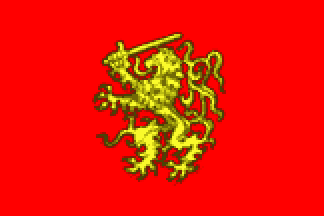
This page is part of © FOTW Flags Of The World website
Portuguese Army
Exército Português
Last modified: 2014-06-29 by klaus-michael schneider
Keywords: army | lion |
Links: FOTW homepage |
search |
disclaimer and copyright |
write us |
mirrors
See also:
Other sites:
- Official
webpage with all the coats of arms of all the current and
deactivated portuguese army units
reported by João Madureira, 23 Apr 2003
The Portuguese Army flag

image by António Martins, 30 Apr 2004
The Portuguese army flag is red with a golden lion holding a sword (well,
I only say this because I’ve seen it in an air show, in the section of army
parashooters).
João Madureira, 02 May 1998
This was some time ago, in "Estoril Air Show 97", held in the Aeródromo
Municipal de Cascais (Cascais Municipal Airstrip) at Tires, from 12 to
14 of September 1997. In the day I visited the show (I don’t remember in which
day), there was a demonstration of the Army (not Air
Force) parachuters.
First, there came some parashooters with smoke on their feet, then a parashooter
with the flag I described, and finally, one with the national flag. The flag
was red with a golden lion rampant holding a sword (also golden but with the
blade in argent). This probably isn’t of the air force because the parachooters
were from the Army, and the emblem of the Air
Force is different.
João Madureira, 04 May 1998
Portuguese Army flags
Talking about flags, [sjcXX] says:
The Army’s heraldic flags are for use on parade, and are
divided into:
- flammes for companies, or equivalent;
- guidons de mérite, for platoons or companies which, having
performed a feat of arms of exceptional worth, have been awarded a
decoration equivalent to, or greater than, the War Cross 1st Class;
- étendards for regiments or equivalent, and exceptionally
for independent companies and battalions;
- gaillardets for generals exercising command, in command of
Arms or Services, or members of the government.
Unit heraldic flags always accompany the commanding
officer on parades.
[sjcXX] quotes from the regulations
— decree 24107 of 3rd June 1969, published in L’Ordre de
l’Armée 1st series, no.6 of 30th June 1969:
- Flamme: an isoceles triangle, bearing the symbol of
the unit, either painted or embroidered.
- Flamme pour marquage: 0.375 m × 0.25 m;
- Flamme pour hisser: 0.5 m × 0.25 m
- Guidon: 0.75m square, bearing a plain, or parti-coloured
border around the arms (or device) of the unit. Embroidered in gold, silver
and silk. Cords and tassels in the heraldic livery colours. The flag is
attached to the staff by three broad loops. There is a second horizontal staff
at right angles to the main staff to keep the flag deployed.
- Guidon de mérite: red with a yellow rampant lion, holding
in its right claws an antique sword, whilst above is an inscription in gold
giving details of the feat of arms, all within a gold border charged
with laurel leaves. Size and staff as the guidon.
- Etendart: 1m square. Divided geometrically with a border
of the “appropriate” metals and tinctures. It is possible to add a
cross or saltire of a suitable metal or tincture. In the centre is a circular
scroll bearing the unit’s name or motto; this encloses the unit coat of
arms, sometimes with a laurel wreath. At each corner of the sheet can be
added either the unit’s abbreviation or number. It is also possible to add
inscriptions about the unit’s feats of arms on the sheet, especially on the
border, but never on the arms or the cross. Cords and tassels in the heraldic
livery colours.
- Gaillardet: square, except for use on vehicles, when it is
0.4 m × 0.3 m. Generals commanding Arms and Services have a plain
flag bearing their respective shields superimposed on the emblem of the Arm or
Service. Generals commanding formations, Quarter-Master General,
Adjutant-General, Vice-Chief of Army Staff, Inspector-General, and Chief
of Army Staff bear a flag with a border in a tincture and a metal,
around “the proper symbol”. Those of members of the Government bear the
“proper symbol” without the border.
Ian Sumner, 19 Dec 2003
Anything below
this line was not added by the editor of this page.

